There is a common perception that playing a backhand is a harder shot than playing a forehand. You just have to watch a beginner or a child learning to play, they naturally want to hit a forehand running around the ball at every chance to get the ball onto their forehand side.
So how to hit a backhand and the best way
My view is that playing a backhand can actually be easier than a forehand. The ball is played in front of you and I believe that it is a more natural stroke, whether it is a one-handed backhand or double-handed.
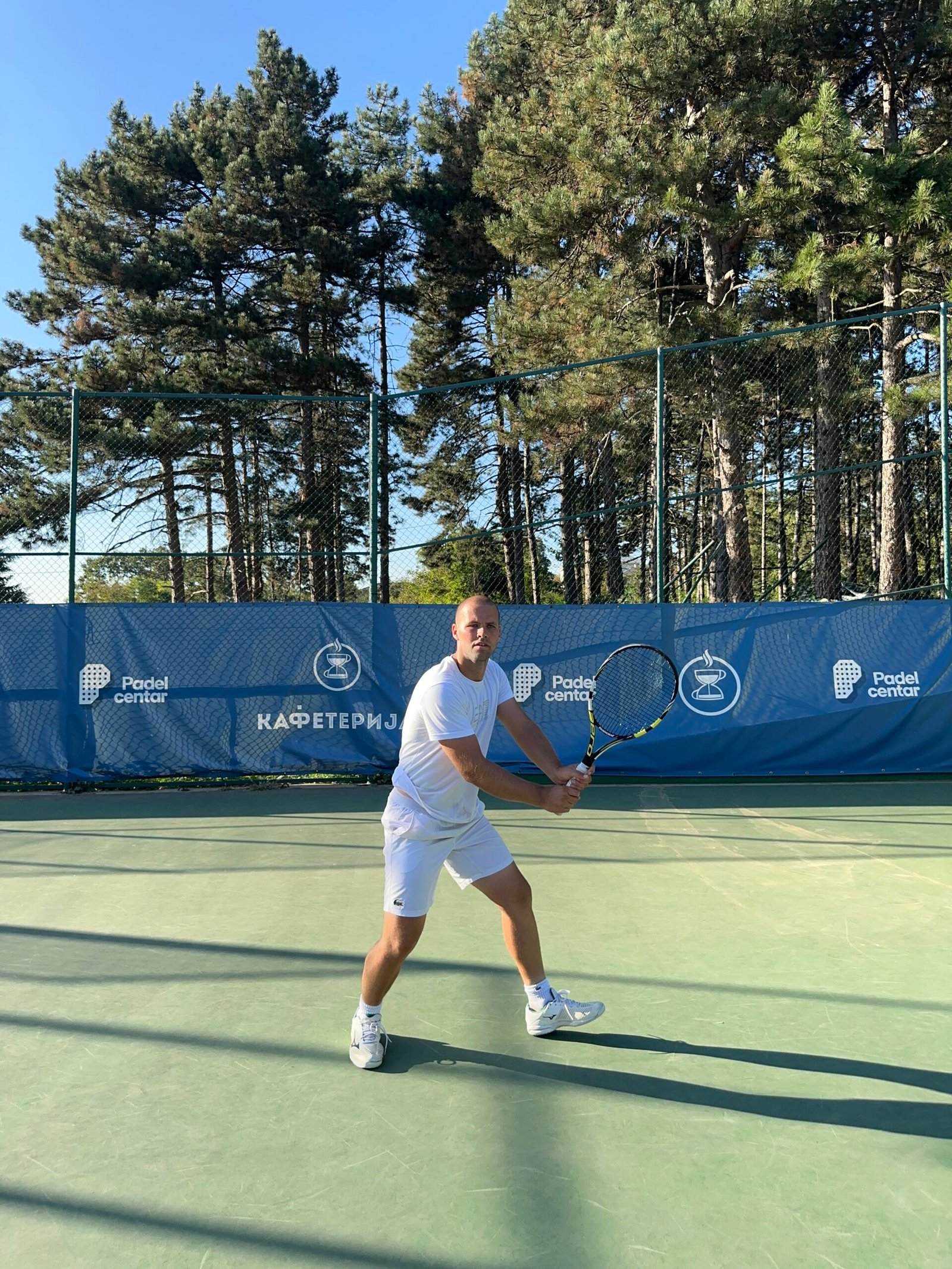
There is no doubt that tennis is a sport that requires a lot of skill, and one of the most important skills to master is the backhand shot. The backhand shot is an essential part of any tennis player’s repertoire, and it can be the difference between winning and losing a match if you have a weakness in your game.
In this article, we will provide tips and techniques for how to hit a backhand in tennis, including the proper grip, stance, and swing.
Understanding the backhand shot is crucial to mastering it. The backhand shot is hit on the non-dominant side of the body and can be executed with either one hand or two. While both one-handed and two-handed backhands have their advantages and disadvantages, it’s important to choose the style that feels most comfortable and natural to the player.
The grip is also an essential aspect of the backhand shot, and it can affect the power and accuracy of the shot. It is important to get it right early so you do not have to change your grip later in your tennis life.
Key Takeaways – How To Hit a Backhand
- Mastering the backhand shot is essential for any tennis player.
- Understanding the proper grip, stance, and swing is crucial to hitting an effective backhand shot.
- Players should choose the backhand style that feels most comfortable and natural to them.
Understanding the Backhand in Tennis
The backhand shot is one of the most important shots in tennis and is often considered the more difficult of the two groundstrokes. A solid backhand can make all the difference in a tennis match, so it is important to understand the fundamentals of the shot.
To hit a good backhand, a player must first have a solid foundation in their footwork and positioning. The player should be facing the net with their feet shoulder-width apart and their weight balanced evenly between both feet. The non-dominant hand should be holding the tennis racket with a continental grip, while the dominant hand should be placed on the throat of the racket.
When hitting a backhand, the player should use a combination of their arm and body to generate power. The player should rotate their hips and shoulders to create torque, while also using their arm to swing the racket through the ball. The player should aim to hit the ball in front of their body and follow through with their swing.
There are two types of backhand shots: the one-handed backhand and the two-handed backhand. The one-handed backhand is typically used by more advanced players and requires more wrist and forearm strength. The two-handed backhand is typically used by beginners and players who prefer a more stable shot.
In conclusion, a good backhand shot is essential for any tennis player. By understanding the fundamentals of the shot and practicing regularly, players can develop a solid backhand and become more confident on the court.
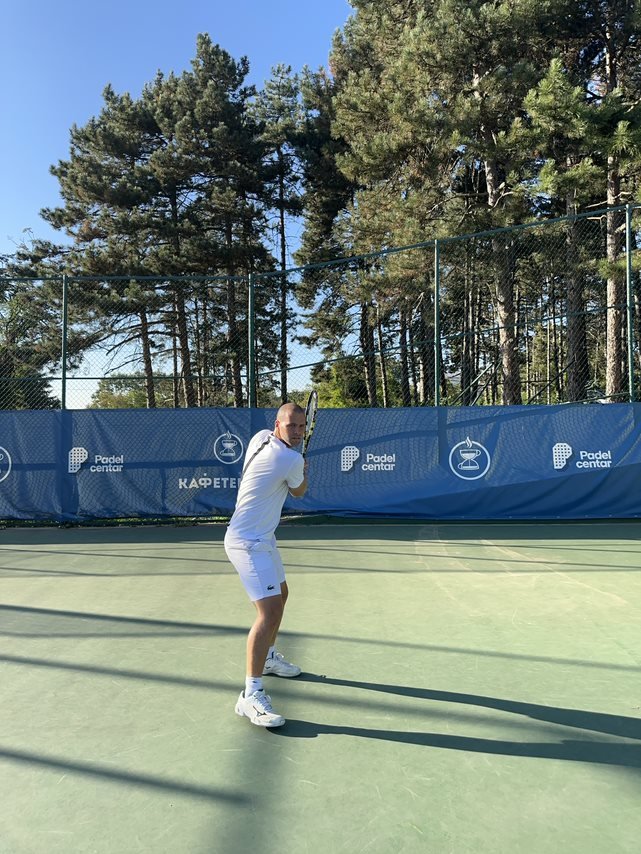
The Importance of the Ready Position
The ready position is one of the most important aspects of hitting a backhand in tennis. The ready position is the stance a player takes when they are waiting for the ball to come to them. It is the foundation for a good backhand shot.
When a player is in the ready position, they should have their non-dominant hand holding the racket at the base of the grip. This hand should be used to help guide the racket into position for the backhand shot. The upper body should be in a neutral stance, with the shoulders squared to the net.
A player’s feet should be shoulder-width apart, with the weight evenly distributed between both feet. The knees should be slightly bent, and the player should be on the balls of their feet. This position allows the player to move quickly in any direction and to react to the ball quickly.
It is important to maintain the ready position throughout the point. When a player hits a backhand shot, they should return to the ready position as quickly as possible. This allows them to be ready for the next shot.
In summary, the ready position is the foundation for a good backhand shot in tennis. It allows a player to move quickly and react to the ball quickly. When a player maintains the ready position throughout the point, they are more likely to hit a good backhand shot.

One-Handed vs Two-Handed Backhand
In tennis, the backhand shot is one of the most important shots in the game. It is essential to master this stroke to become a good tennis player. One of the most important decisions a player has to make is whether to hit a one-handed or two-handed backhand.
One-Handed Backhand
A one-handed backhand is a stroke that is executed with one hand on the grip of the racket. This stroke requires a lot of skill, as it is more difficult to control the ball with one hand. Generally, players with a one-handed backhand have a better reach, as they can stretch out further to hit the ball. This stroke is usually used for slice shots, drop shots, and volleys.
Two-Handed Backhand
A two-handed backhand is a stroke that is executed with both hands on the grip of the racket. This stroke is easier to control, as the player has more stability and power. Generally, players with a two-handed backhand have more power and consistency, as they can generate more racket head speed. This stroke is usually used for topspin shots and passing shots.
Dominant Arm and Non-Dominant Side
When choosing between a one-handed or two-handed backhand, a player should consider their dominant arm and non-dominant side. If a player has a strong dominant arm, they may prefer a one-handed backhand. Conversely, if a player has a weaker dominant arm, they may prefer a two-handed backhand. It is also important to consider the non-dominant side of the body. A player may have a weaker non-dominant side, which could affect their ability to hit a one-handed backhand.
In conclusion, both the one-handed and two-handed backhands have their advantages and disadvantages. A player should choose the stroke that suits their playing style and physical abilities.
Mastering the Backhand Grip
The grip is one of the most important aspects of hitting a backhand in tennis. The right grip can help generate power and control the ball’s direction. There are three main types of backhand grips: the continental grip, the eastern backhand grip, and the western grip.
The continental grip is the most versatile grip and is often used for volleys and serves. To use this grip for a backhand, the player should place the base knuckle of their index finger on the second bevel of the racket handle. This grip allows for a flat backhand shot and is ideal for players who like to hit the ball early.
The eastern backhand grip is a popular grip used by many professional players. To use this grip, the player should place the base knuckle of their index finger on the third bevel of the racket handle. This grip allows for topspin and is ideal for players who like to hit the ball with a lot of spin.
The western grip is a more extreme grip used by players who like to hit with a lot of topspin. To use this grip, the player should place the base knuckle of their index finger on the fourth bevel of the racket handle. This grip allows for a high degree of topspin and is ideal for players who like to hit the ball with a lot of power.
It’s important to note that the grip should be comfortable and natural for the player. The player should experiment with different grips and find the one that feels best for them. Once the player has found the right grip, they should practice hitting the ball with it until it feels natural.
In conclusion, the backhand grip is an important aspect of hitting a backhand in tennis. There are three main types of backhand grips: the continental grip, the eastern backhand grip, and the western grip. The player should experiment with different grips and find the one that feels most comfortable and natural for them.
Perfecting the Backhand Swing
The backhand swing is one of the most important shots in tennis. It is a shot that requires proper technique and practice to master. A good backhand swing can help players hit powerful and accurate shots that can help them win points. In this section, we will discuss how to perfect the backhand swing.

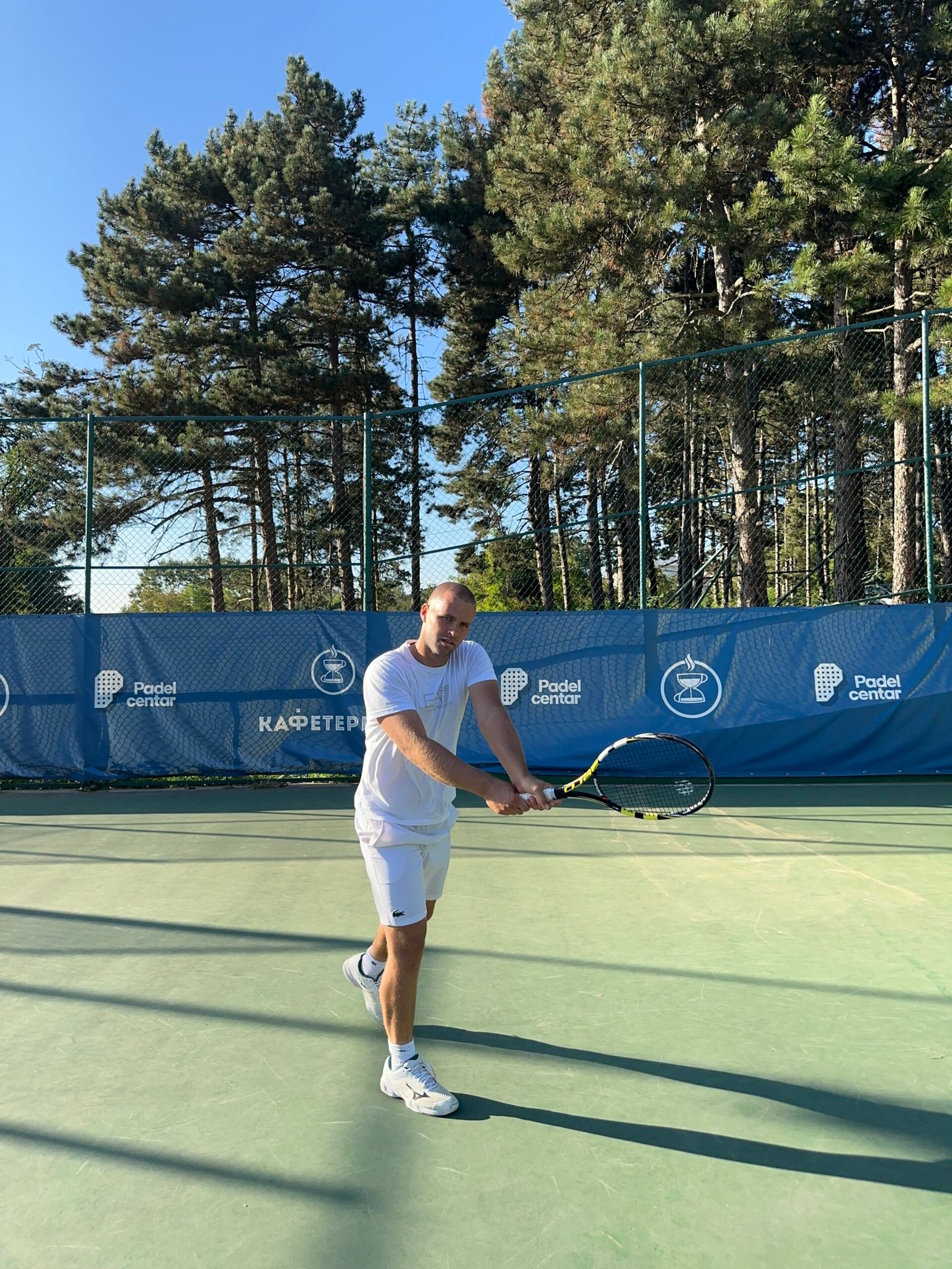
Grip
The first step in perfecting the backhand swing is to have the proper grip. The grip is the foundation of the shot and determines how the racket head will move through the ball. For a two-handed backhand, the player should hold the racket with both hands, with the dominant hand on the bottom and the non-dominant hand on top. The grip should be firm but not too tight, and the player should be able to move the racquet head freely. Look at Miki’s grip in this photo, it gives a good outline of the position of the hands.
Swing
The backhand swing begins with the player’s feet shoulder-width apart and facing the net. The player should have his or her weight on the back foot and be ready to transfer it to the front foot as the swing begins. The player should then bring the racquet head back and up, keeping the elbow close to the body. As the racquet head comes forward, the player should rotate his or her hips and shoulders, bringing the racquet head through the ball. The player should finish the shot with the racquet head pointing towards the target.
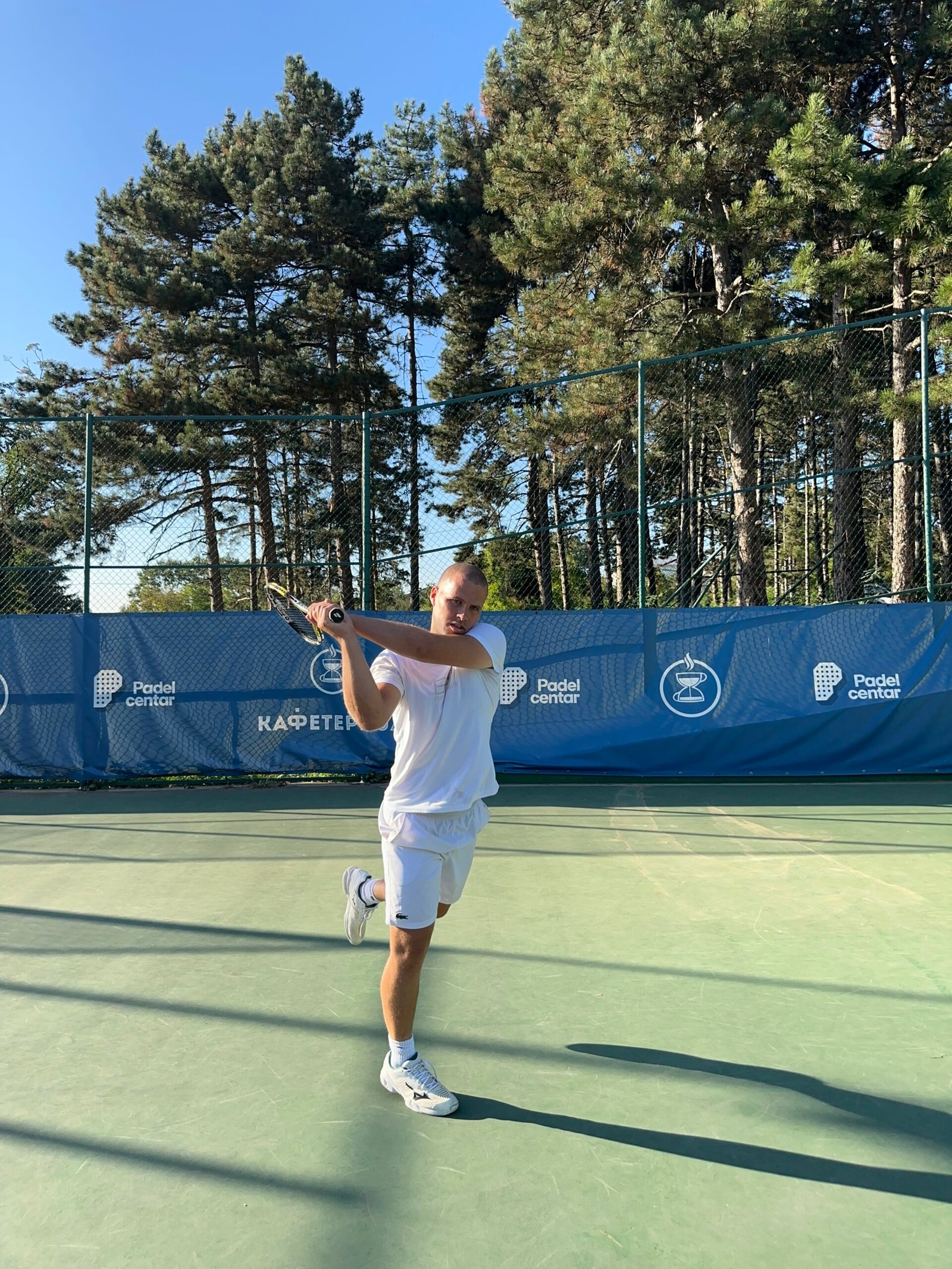
Follow-through
The follow-through is an important part of the backhand swing. After hitting the ball, the player should continue the swing, bringing the racquet head up and over the opposite shoulder. This will help the player maintain balance and control during the shot. The follow-through should be smooth and fluid, and the player should avoid stopping abruptly after hitting the ball.
In conclusion, perfecting the backhand swing is essential for any tennis player who wants to improve his or her game. By focusing on the grip, swing, and follow-through, players can develop a powerful and accurate backhand shot that can help them win points and matches. With practice and dedication, anyone can master the backhand swing and become a better tennis player.
Achieving the Ideal Contact Point
One of the most important aspects of hitting a backhand in tennis is achieving the ideal contact point. The contact point is the point at which the racquet makes contact with the ball during the swing. It is crucial to hit the ball at the right contact point to ensure a clean and effective shot.
The ideal contact point for a backhand is generally at or slightly in front of the body, with the ball at or slightly below shoulder height. This allows the player to generate power while maintaining control over the shot. It is important to keep the wrist firm and the racquet face square at the point of contact to ensure a clean hit.
Players should aim to hit the ball in the center of the racquet’s sweet spot. This is the area of the racquet that produces the most power and control. A good way to practice hitting the ball in the sweet spot is to place a small piece of tape on the racquet’s face and aim to hit the ball within the confines of the tape.
Another important factor in achieving the ideal contact point is footwork. Players should position themselves correctly about the ball to ensure they are hitting the ball at the right height and angle. This may involve moving forward or backward or adjusting the stance to accommodate different shot types.
In summary, achieving the ideal contact point is crucial to hitting an effective backhand in tennis. Players should focus on hitting the ball at or slightly in front of the body, with the ball at or slightly below shoulder height. They should aim to hit the ball in the center of the racquet’s sweet spot and maintain a firm wrist and square racquet face at the point of contact. Proper footwork is also important in achieving the ideal contact point.
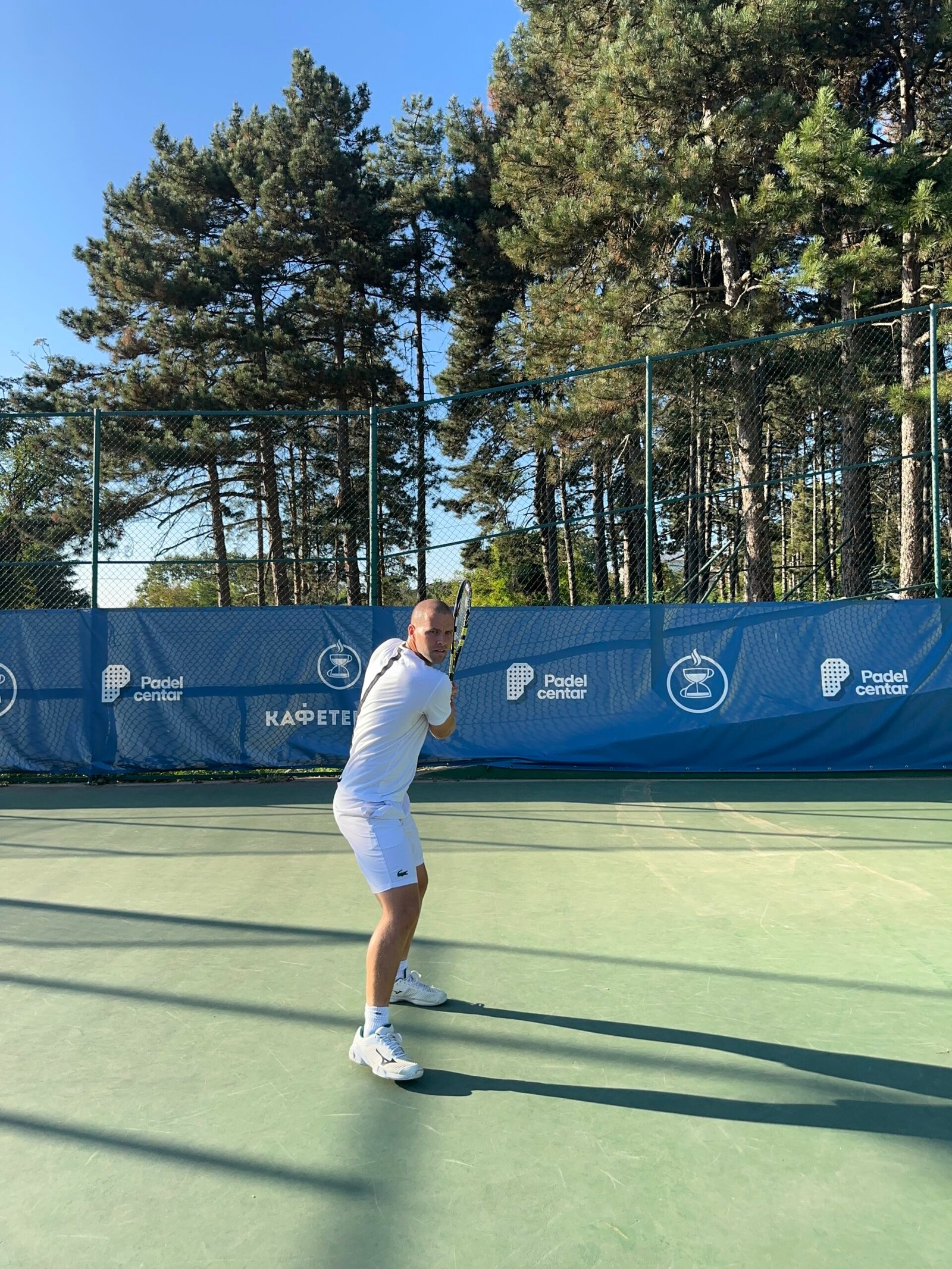
Body Movement and Stance
To hit a backhand in tennis, the player needs to have proper body movement and stance. The player should stand with their feet shoulder-width apart and their knees slightly bent. The player should also have a slight forward lean towards the net.
The left shoulder plays a crucial role in the backhand swing. The player should keep their left shoulder pointed towards the net throughout the swing. This will help the player maintain balance and generate power.
The right arm should be extended fully, and the player should keep their left hand on the throat of the racket. This will allow the player to generate maximum power and control on the shot. The front foot should be pointed toward the net, and the back foot should be perpendicular to the net.
The player should initiate the backswing by turning their right shoulder towards the net. This shoulder turn will allow the player to generate power and control on the shot. The player should also keep their eye on the ball throughout the swing.
In conclusion, to hit a backhand in tennis, the player needs to have proper body movement and stance. The left shoulder, right arm, left hand, front foot, back foot, right shoulder, and shoulder turn all play crucial roles in the backhand swing. By following these guidelines, the player can improve their backhand shot and become a better tennis player.
Dealing with High and Deep Balls
When hitting a backhand, dealing with high and deep balls can be a difficult shot to execute. However, with the right technique and practice, players can master this shot and turn it into an advantage.
To handle high balls, players should adjust their position and footwork to get into the right position. The player should move back and position themselves behind the ball, with their body weight on their back foot. This will allow the player to create more space and time to prepare for the shot.
When hitting the backhand, players should use a continental grip, which allows them to generate more topspin and control over the ball. They should also aim to hit the ball at the highest point possible, which will help them to hit the ball with more power and accuracy.
To deal with deep balls, players should focus on their footwork and positioning. They should move back quickly to get behind the ball and then use their momentum to move forward and hit the ball. It is important to maintain good balance and stay low to the ground to generate more power and control over the shot.
Players can also use slice shots to handle deep balls. A slice shot is a backhand shot that is hit with a slicing motion, which causes the ball to spin and drop quickly over the net. This shot is particularly effective against deep balls, as it allows the player to hit the ball with more accuracy and control.
In summary, dealing with high and deep balls in tennis requires good footwork, positioning, and technique. With practice and patience, players can master this shot and turn it into an advantage on the court.

Learning from the Best
One of the best ways to improve your backhand in tennis is to learn from the best players in the world. Players like Roger Federer, Richard Gasquet, and Dominic Thiem are known for their exceptional backhand skills, and studying their techniques can help you improve your own game.
For example, Roger Federer is known for his one-handed backhand, which he uses to great effect on the court. His backhand is characterized by its smooth, fluid motion, and he can generate a lot of power and spin with it. To improve your backhand, you can try to emulate Federer’s technique by focusing on your footwork, grip, and swing.
Similarly, Richard Gasquet is known for his elegant one-handed backhand, which he has used to great effect throughout his career. His backhand is characterized by its effortless power and accuracy, and he can hit a variety of shots with it, including topspin, slice, and drop shots. To improve your backhand, you can try to emulate Gasquet’s technique by focusing on your footwork, grip, and swing.
Dominic Thiem is another player with a strong backhand, and he is known for his two-handed backhand, which he uses to great effect on the court. His backhand is characterized by its power and consistency, and he can hit a variety of shots with it, including topspin, slice, and flat shots.
My personal favorite is Novak Djokovic, In my view, he is the player who has the best backhand of all time. I have not seen someone with the range of options he has. Novak plays with a two-handed backhand and is comfortable playing either defense or offense. He uses the eastern grip on his top hand (left hand) and the continental grip on his bottom hand (right hand) when he hits the backhand which allows him control and accuracy. He rarely misses the ball on this flank which is rare for players. Combine this consistency with his balance and court craft and he is hard to break down on this side.
In addition to studying the techniques of top players, it can also be helpful to work with a tennis coach to improve your backhand. A good coach can help you identify areas where you need to improve and can provide you with personalized drills and exercises to help you develop your skills.
Finally, it’s worth noting that even club-level players can benefit from studying the techniques of top players and working with a coach to improve their backhand. By focusing on the fundamentals of footwork, grip, and swing, and by practicing regularly, anyone can improve their backhand and become a more effective player on the court.
Common Mistakes and How to Avoid Them
Even experienced tennis players can make mistakes when hitting a backhand shot. Here are some common mistakes and tips on how to avoid them:
1. Poor Footwork
Footwork is crucial when hitting a backhand shot in tennis. A lot of players make the mistake of not positioning themselves properly on the court. It’s important to have a good idea of where the ball is going to land and move quickly to get in position. One way to improve footwork is to practice shuffle steps to make quick adjustments.
2. Incorrect Grip
Using the wrong grip can lead to a lot of errors when hitting a backhand shot. The most important thing is to find a grip that feels comfortable and natural. A good starting point is to try the Eastern or Western grip. The Eastern grip is a good option for beginners or those with a more classic playing style, while the Western grip is ideal for players who like to hit with more spin.
3. Poor Timing
Timing is everything when hitting a backhand shot in tennis. It’s important to coordinate the upper and lower body movements to generate power and control over direction and pace. One common mistake is to swing too early or too late. It’s a good idea to practice the swing motion in slow motion to get the timing right.
4. Lack of Follow-Through
A lot of players make the mistake of stopping the swing motion too soon. It’s important to follow through with the swing to maximize power and control over the shot. A good follow-through involves extending the arm fully and rotating the wrist to finish the shot.
By avoiding these common mistakes, players can improve their backhand shots and become more effective on the court.
Frequently Asked Questions
Should I hit a one-handed backhand or a double-handed backhand
Totally up to you. Nowadays most people learning the game, particularly juniors, will learn to hit a double-handed backhand as it is easier and two hands offers more support to what is a harder shot. Try both and see what works best for you. It is interesting to see the best of the best players currently on the ATP and WTA tours both usually play with a double-handed backhand.
How can I improve my one-handed backhand in tennis?
Improving a one-handed backhand in tennis requires practice and patience. A good starting point is to focus on the basics, such as footwork, grip, and swing technique. Players should also work on developing their core strength and flexibility, which can help improve their overall backhand stroke. Additionally, practicing with a coach or hitting partner can help players identify areas for improvement and receive feedback on their technique.
What is the difference between a one-handed and two-handed backhand in tennis?
The main difference between a one-handed and two-handed backhand in tennis is the grip used to hold the racket. A one-handed backhand is played with a continental grip, while a two-handed backhand is played with an eastern or semi-western grip. The two-handed backhand provides more stability and power, while the one-handed backhand offers more reach and flexibility. Ultimately, the choice between a one-handed and two-handed backhand comes down to personal preference and playing style.
What are some effective tennis backhand drills?
There are several effective tennis backhand drills that players can use to improve their technique and consistency. One popular drill is the cross-court backhand rally, where players hit backhand shots to each other’s backhand side in a cross-court pattern. Another drill is the backhand slice drill, where players practice hitting low, spinny shots with their backhand. Additionally, players can practice hitting backhand shots on the run, which can help improve their footwork and balance, this is a hard shot so practice needed.
What is the correct grip for a tennis backhand?
The correct grip for a tennis backhand depends on whether a player is hitting a one-handed or two-handed backhand. For a one-handed backhand, players should use a continental grip, which involves holding the racket with the base knuckle of the index finger on the third bevel of the racket handle. For a two-handed backhand, players should use an eastern or semi-western grip, which involves holding the racket with the base knuckle of the index finger on the second bevel of the racket handle, and the non-dominant hand supporting the racket handle.
What are the key cues for hitting a successful tennis backhand?
The key cues for hitting a successful tennis backhand include good footwork, a relaxed grip, and a smooth, fluid swing. Players should focus on keeping their feet moving and staying balanced throughout the stroke. They should also aim to keep their grip relaxed and loose, which can help generate more racket head speed and power. Finally, players should focus on hitting through the ball with a smooth, fluid motion, rather than trying to muscle the shot.
Final Thoughts
This article gives you a good overview of the things you need to have in place to make sure your backhand can achieve great heights. It is not an easy shot for most people to hit, that said practice makes the purpose and the more you can practice the shot in a match or practice game the more confidence you will have. Let us know how you get on.
Related Articles:
How to Hit a Forehand in Tennis – Our Top Tips Revealed – Tennis Pursuits
How to Volley in Tennis? Top Tips On Technique – Tennis Pursuits
How to Hit a Kick Serve? Top Tips From a Professional – Tennis Pursuits


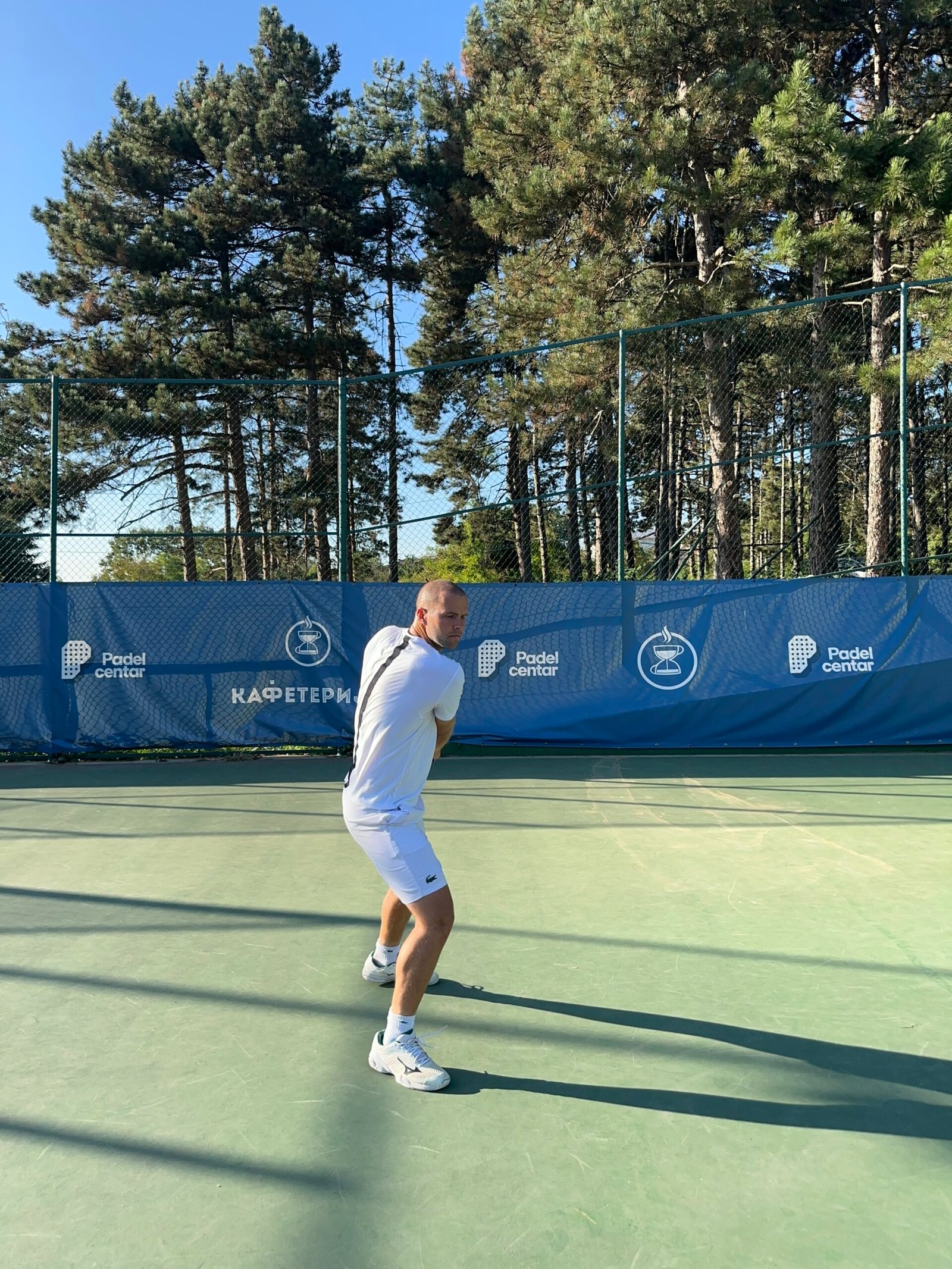
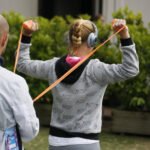

Comments are closed.